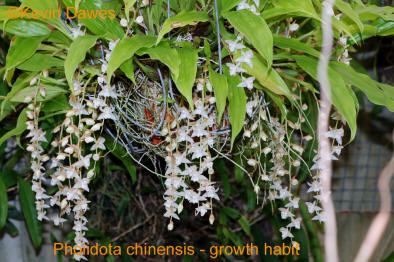Pholidota chinensis is a widely cultivated orchid and probably the best known of this closely related group. From China (hence the name) and Vietnam it is an easy growing, tough plant and can produce a mass of pendulous spikes, each with up to 20 small white to pinkish flowers. It is very quick growing and will soon form a good specimen size. At full height it won't be much over 30 cm so it doesn't take much space. It prefers an intermediate (warmish) environment with plenty of moisture and humidity.
The lower image above is of a plant labelled Coelogyne primulina that was awarded by a judging panel in my area recently! Even at high levels there is much ignorance and confusion! I do have a more professional reason for including this image, however.
If you examine the pot closely you can see the efforts made to ensure perfect drainage. These containers with slots down the side need to be watched carefully though as they can dry out much more quickly too. Another thing to notice is the moss growing in the pot. This indicates that the plant is getting lots of moisture and humidity. Finally, notice how it is happy to have many roots growing outside the pot. This is the case in both images. I mention this specifically because many people panic at this stage and feel the plant needs to be repotted to contain all the roots. A lot of orchids (and Coelogynes) like to have their roots growing into air spaces. Generally their environment is so moist that these roots are still doing their job collectingmoisture and also fertiliser from dripping vegetation around and above them.
Because its flowers are pendulous, it suits a hanging pot or basket. An alternative is to sit it on a pedestal while it is flowering so that the flowers can be appreciated.
Negatives: They generally only flower once per year in late Spring/Summer and the flowers only last about two weeks. The lush plant leaves have a tendency to over-shadow the smallish flowers.
Rating: ♦♦♦♦ It is small, attractive and very worth collecting because of its compact size and heavy flowering characteristics. It is the first Pholidota that I would recommend non-collectors to grow.
Sometimes sold as:
- Coleogyne corniculata
- Coelogyne pholas
- Coelogyne primulina
- or as some other Pholidota.
Varieties: I have a white flowering form but it would be more accurate to describe it as cream and apart from someone with a collector's mentality, it is probably not worth chasing hard to get.
Hybrids: None registered

